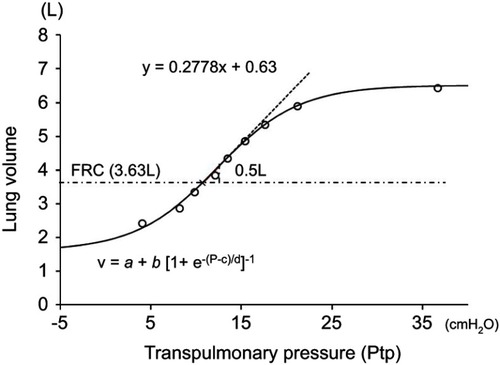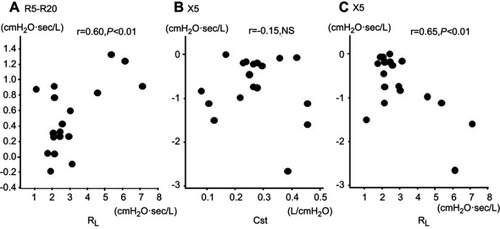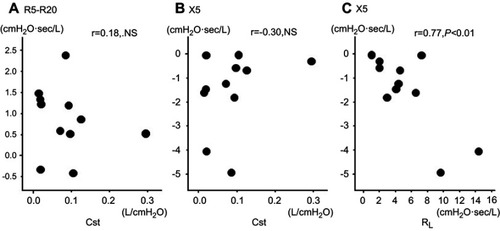Figures & data
Figure 1 Sigmoidal regression analysis fitted to the data and calculation of static lung compliance in one healthy subject.
Abbreviations: FRC, functional residual capacity; Ptp, transpulmonary pressure; Cst, static lung compliance.

Table 1 Characteristics and the results of pulmonary function test of healthy subjects and patients with obstructive lung disease and interstitial lung disease
Figure 2 Percentage drop in Cdyn from Cst in accordance with the increased respiratory frequency in healthy subjects, patients with obstructive lung disease and interstitial lung disease.
Abbreviations: Cdyn, dynamic lung compliance; Cst, static lung compliance; HS, healthy subjects; OLD, obstructive lung disease; ILD, interstitial lung disease.

Table 2 Results of respiratory impedance measured by the multifrequency forced oscillation technique in healthy subjects, patients with obstructive lung disease, and interstitial lung disease
Table 3 Correlations between parameters of respiratory impedance and pulmonary function tests among healthy subjects and patients with obstructive lung disease and interstitial lung disease (total 53 subjects)
Table 4 Correlations between parameters of respiratory impedance and pulmonary function tests in 18 patients with obstructive lung disease
Table 5 Correlations between parameters of respiratory impedance and pulmonary function tests in 11 patients with interstitial lung disease
Figure 3 Relationships between lung resistance and R5–R20 (A) or X5 (C), and between static lung compliance and X5 (B) in obstructive lung disease. Hz.Abbreviations: R5, respiratory resistance at 5 Hz; R20, respiratory resistance at 20 Hz; R5–R20, difference from R20 to R5; X5, respiratory reactance at 5 Hz; RL, lung resistance; Cst, static lung compliance.

Figure 4 Relationships between static lung compliance and R5–R20 (A) or X5 (B), and between lung resistance and X5 (C) in interstitial lung disease. R5–R20: difference in resistance at oscillation of 5 Hz and 20 Hz; X5, reactance at oscillation of 5 Hz.

